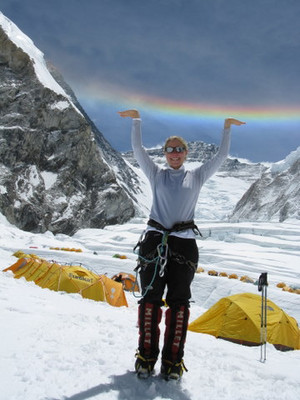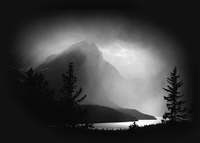Everest Epilogue

On the night of the 7th May or early morning of 8th Our little group set out for Camp One, this was to be the final cycle of acclimatisation for Cheryl, Nikki and me.
It was always dark and cold when we left base camp. It had to be, because the idea was to reach Camp One before the inevitable sun trapped us in the baleful seracs and crevasses of the Ice Fall. Every day we spent in the Ice Fall and Western Cwm was memorable for the wildly fluctuating temperatures. For about 10 minutes at some indefinable moment in the early morning the temperature was perfect, the views incredible and it all seemed worthwhile. Before that moment it was generally too damned cold, and after that brief interlude, too damned hot. The heat was the worse curse. we cold always pull on more clothes against the cold, but the heat... nothing can be done about that. Not with all the UV and other varieties of extreme radiation. So we staggered on into the cold and dark, trying to avoid the trip wires of the neighbouring team's tent guy lines and ankle snapping surface rocks on the glacier.
Dawn arrived gray and wan, and climbers on their way down from Camp 1 began to have welcome news. The Chinese torch had at last reached the top of the mountain.
There had been so many rumours:
-That they had tried on 1 May (of course!) but the torch had blown out in the wind. -That several Tibetans had already reached the top but they did not count as true Chinese.
-That they had tried without Tibetans, and that was why they failed. -That they should have used Russel Brice (Mr North Side) to fix the ropes, but they were too xenophobic.... and so on.
Passing climbers said they had heard by satellite phone from home that the video footage of the torch on the summit was already going round the world. That was at 0600hrs local time. By 0700hrs the news was that the army was preparing to move out of our base camp.
And then, the most extraordinary sight began to fill the sky, from 8:30am to 10:30am. At first there was a circular rainbow round the sun, very bright against the dark high altitude sky. Then a white ring began to form, exactly the same diametre as the rain bow, intersecting the sun to make the first two rings of the Olympic logo.
“Oh, it's a sign!”
“No... it's a logo”
“That's great for Beijing, the Olympic sign in the sky!”
“But it's only two rings... maybe that means it will only be two fifths successful!” “Really “ said Ang Dorji “it is the sign of the Dalai Lama”
And so we wittered on till we reached Camp One where we saw the astonishing upside down rainbow over Lhotse – it curved the wrong way. (photo)
Two days later Cheryl, Nikki and I were at Camp Three, making hot drinks till we no longer felt dehydrated; waking up at midnight to make yet more drinks just in case. This was as high as we needed to go before the final push. Our acclimatising was now complete. The weather had been near perfect during the entire Chinese effort, and now we could only hope it would continue to be good to us.
Our sub unit of three had been one day ahead of the main group, who, under the leadership of Mike Roberts caught us up in base camp. The three days in base were spent in a mildly nervous sate. Some members resting and doing nothing else, others walking up to Pumori's camp one where both the North Ridge and the South Col routes could be easily seen. Mike, Ang Dorjee, and I pored over the weather reports, looking for some wrinkle in the pattern that would favour us.
There were three main sources of weather information; the Americans had Michael Fagin, he consistently over predicted the winds, and in fact got it completely wrong for 25 may when he predicted 50 knot winds (it was to be the lowest wind day of the entire spell) as did the UK based 'Bracknel' forecast. Bracknel have now mis-predicted summit days on three occasions for me; once nearly costing me my life. As Dorothy Parker once said, their forecasts are not to be tossed aside lightly, but to be thrown with great force. The one bright spot in the fore casting firmament was the Swiss , which was pretty much spot on. This was backed up by another excellent source at www.meteoexploration.com.
Our base camp neighbours and friends, Kari Kobler and Kenton Cool (who was leading a team with Sir Ranulphe Fiennes as the star member) both relied on the Swiss forecast, Kari opting for a summit day on 21 May while Kenton chose to try for 24 May; so did we. They were all pretty good days in the end, with a period of low(ish) winds lasting from 21 to 26 or 27 May.
The whole team began the summit cycle early on 19 May. On 22 May while we were at camp, news began to trickle through the radio of a rescue mission. Four head torches were seen to be descending very slowly and very late from the summit.
By 8:40pm the group had been out almost 24 hours. They reported some frostbite and some HACE. A Swiss expedition was sending a doctor and a Sherpa with oxygen up to help them. Our friend Dave Morton offered to postpone or give up his own summit attempt to help.
At 8:56pm The NZ member of the group reported that the rescue was under control. soon after that the Doctor and Sherpa arrived and the radios went silent.
It was only the next day we heard the Swiss climber had made it to within 5 minutes of Camp Four, where he stopped moving and died. This was shocking news, and it brought home just how serious Everest can be, and how quickly it can all go wrong above 8,000m.
Our summit day began the day before, leaving Camp Four at the rather early hour of 8pm, the idea being to avoid the large AAI group who were setting out at 9pm.
It was a cold, cold night. A steady 30 knot wind blew from the South West, which combined with minus 20 or 25 degree Celcius temperatures produced chill factor I would rather not think of. The first summiteers of the day were members of our group, Ang Dorjee and Robyn Faike arrived at 4:04am on 24 June. Not far behind were the rest of us.
The whole AC team reached the top, and returned to base camp safe and sound. No frost bite, no injuries from falling off the final ladders (it happens!). This was a real success. The other teams that night were not so lucky, with several (minor I hope) cold injuries being reported.
In retrospect the short summit window this year proved to be interesting and maybe even controversial, from a couple of pints of view:
Firstly there seem to have been several cases of climbers temporarily losing sight in one or both eyes on summit day. They generally reported their vision going “white” and loss of vision was total. One climber described his eyes being covered in 'cotton wool', another that it began 'like a film of vaseline'. At least two were wearing goggles at the time (this should rule out frozen corneas). All reported improvement and total reversal of the symptoms while resting at Camp Four.
Secondly there seems on our cold summit night to have been some problems with freezing oxygen mask valves. Because of the circumstances, the cold, the wind (and a bit of hypoxia) it is quite hard to reconstruct or deduce exactly what was going on there. Ang Dorjee went from the balcony to the south summit more or less without bottled oxygen as a result. I guess we will have to find a cold store and a strong fan to reproduce the conditions.
Finally, controversially, there was more “tent poaching” than usual. Last year a Korean team used our tents with out asking, leaving them torn and littered. This year this execrable behaviour has been extended. The West Canadian team had a type one diabetic who arrived at Camp Four with a guide to find the team from a British company had occupied their tents. The Canadians helped the British erect their own tents, and then found that the Canadian gas and food had been depleted to the extent there was only enough food left sfor one meal for one person.
Over on Lhotse, there were numerous reports of Spanish and Italian tent poachers. One Italian couple had decided not to carry tents, nor food nor gas. They returned from the summit of Lhotse to find all the tents at Lhotse's Camp Four occupied with legitimate owners, and eventually were able to beg a space in one of them.
David Liano, an experienced Mexican climber pointed out a common theme “they were all originally going to the North Side”. I do not know if this was, strictly speaking, correct; but if so, then these are the people who planned to make use of the infrastructure of Russel Brice and his colleagues. The South side will be well rid of them next year.
We began the expedition in a royal kingdom, and finished it in a democratic republic. We had a tiny little taste of military rule, the senseless arbitrariness of it all. And yet, Spring 2008, inspite of all the ploitical shenanigans, the tent poaching and shortened period above Camp Two has proved to be something of a vintage season. We will all have cause to remember it.

